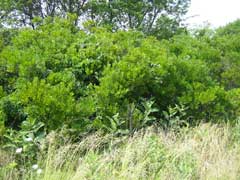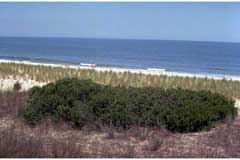 |
|
www.flickr.com/photos/53817483@N00 |
 |
| USDA-NRCS PLANTS Database |
Translate this page:
Summary
It is also classified as Morella pensylvanica.
Physical Characteristics

 Myrica pensylvanica is a deciduous Shrub growing to 3 m (9ft) by 3 m (9ft).
Myrica pensylvanica is a deciduous Shrub growing to 3 m (9ft) by 3 m (9ft).
See above for USDA hardiness. It is hardy to UK zone 2. It is in flower from April to May, and the seeds ripen in October. The species is monoecious (individual flowers are either male or female, but both sexes can be found on the same plant) and is pollinated by Wind.
It can fix Nitrogen.
Suitable for: light (sandy), medium (loamy) and heavy (clay) soils and prefers well-drained soil. Suitable pH: mildly acid and neutral soils and can grow in very acid and saline soils.
It can grow in semi-shade (light woodland) or no shade. It prefers dry or moist soil.
UK Hardiness Map
US Hardiness Map
Synonyms
M. carolinensis. non Mill. M. cerifera latifolia.
Plant Habitats
Woodland Garden Sunny Edge; Dappled Shade; Hedge;
Edible Uses
Edible Parts: Fruit
Edible Uses: Condiment
Fruit - raw or cooked. The fruit is about 4mm in diameter and contains a single large seed[200]. There is very little edible flesh and this is of poor quality[K]. The leaves and fruit are used as a food flavouring in soups etc[62, 102, 183]. A bay leaf substitute, imparting a delicate aroma and subtle flavour[183]. The herb is removed before the food is served[183].
References More on Edible Uses
Medicinal Uses
Plants For A Future can not take any responsibility for any adverse effects from the use of plants. Always seek advice from a professional before using a plant medicinally.
The root bark is astringent and emetic in large doses[222]. A tea made from the leaves is used in the treatment of fevers and externally as a wash for itchy skin[222].
References More on Medicinal Uses
The Bookshop: Edible Plant Books
Our Latest books on Perennial Plants For Food Forests and Permaculture Gardens in paperback or digital formats.

Edible Tropical Plants
Food Forest Plants for Hotter Conditions: 250+ Plants For Tropical Food Forests & Permaculture Gardens.
More

Edible Temperate Plants
Plants for Your Food Forest: 500 Plants for Temperate Food Forests & Permaculture Gardens.
More

More Books
PFAF have eight books available in paperback and digital formats. Browse the shop for more information.
Shop Now
Other Uses
Dye Hedge Hedge Wax
A wax covering on the fruit is extracted by scalding the fruit with boiling water and immersing them for a few minutes, the wax floats to the surface and is then skimmed off. The fruit is then boiled in water to extract the wax from the pulp and once more the wax is skimmed off. It is then strained through a muslin cloth and can be used to make aromatic candles[46, 106, 171]. Candles made from this wax are quite brittle but are less greasy in warm weather[213]. They are slightly aromatic, with a pleasant balsamic odour[245], and do not smoke when put out, making them much more pleasant to use that wax or tallow candles[213]. The wax is also used in making soaps[213]. A green dye is obtained from the leaves[106]. The plant is very wind hardy and can be grown as an informal hedge[200]. Carbon farming - Industrial Crop: wax. Agroforestry Services: nitrogen.
Special Uses
Carbon Farming Food Forest Hedge Hedge Nitrogen Fixer
References More on Other Uses
Cultivation details
Agroforestry Services: Nitrogen Industrial Crop: Wax Management: Standard Regional Crop
It is a temperate plant. Prefers a moist soil. Grows well in an open position in a well-drained soil in sun or light shade[200]. Thrives in any ordinary garden soil[11]. Prefers a lime-free loamy or peaty soil[1]. Does well in dry maritime sites[200]. Hardy to about -40°c[200]. Closely related to M. cerifera and perhaps no more than a hardier northern form of it[11], it has larger fruits than M. cerifera[182]. Where their ranges overlap, Myrica pensylvanica hybridizes quite readily with both M . cerifera and M . Heterophylla[270]. Tolerant of salt spread on roads[200]. Plants in this genus are notably resistant to honey fungus[200]. Many species in this genus have a symbiotic relationship with certain soil micro-organisms, these form nodules on the roots of the plants and fix atmospheric nitrogen. Some of this nitrogen is utilized by the growing plant but some can also be used by other plants growing nearby[200]. Carbon Farming - Climate: cold to warm temperate. Humidity: humid. Cultivation: regional crop. Management: standard. The plant is heat tolerant in zones 6 through 1. (Plant Hardiness Zones show how well plants withstand cold winter temperatures.
Plant Heat Zones show when plants would start suffering from the heat.
The Plant Heat Zone map is based on the number of "heat days" experienced in a given area where the temperature climbs to over 86 degrees F (30°C).
At this temperature, many plants begin to suffer physiological damage. Heat Zones range from 1 (no heat days) to 12 (210 or more heat days).
For example Heat Zone. 11-1 indicates that the plant is heat tolerant in zones 11 through 1.) For polyculture design as well as the above-ground architecture (form - tree, shrub etc. and size shown above) information on the habit and root pattern is also useful and given here if available. A clumping plant, forming a colony from shoots away from the crown but with a limited spread [1-2]. The root pattern is flat with shallow roots forming a plate near the soil surface [1-2]. The root pattern is a heart root, dividing from the crown into several primary roots going down and out [1-2]. The root pattern is stoloniferous rooting from creeping stems above the ground [1-2].
Carbon Farming
-
Agroforestry Services: Nitrogen
Plants that contribute to nitrogen fixation include the legume family – Fabaceae.
-
Industrial Crop: Wax
Water resistant, malleable substances. Currently, most commercial wax is made from paraffin - a fossil fuel.
-
Management: Standard
Plants grow to their standard height. Harvest fruit, seeds, or other products. Non-Destructive management systems.
-
Regional Crop
These crops have been domesticated and cultivated regionally but have not been adopted elsewhere and are typically not traded globally, Examples in this broad category include perennial cottons and many nuts and staple fruits.
References Carbon Farming Information and Carbon Sequestration Information
Temperature Converter
Type a value in the Celsius field to convert the value to Fahrenheit:
Fahrenheit:
The PFAF Bookshop
Plants For A Future have a number of books available in paperback and digital form. Book titles include Edible Plants, Edible Perennials, Edible Trees,Edible Shrubs, Woodland Gardening, and Temperate Food Forest Plants. Our new book is Food Forest Plants For Hotter Conditions (Tropical and Sub-Tropical).
Shop Now
Plant Propagation
Seed - best sown as soon as it is ripe in the autumn in a cold frame. Barely cover the seed and keep it moist. Stored seed germinates more freely if given a 3 month cold stratification and then sown in a cold frame. Germination is usually good[78]. Prick out the seedlings into individual pots when they are large enough to handle and grow on in the cold frame for the first winter. Plant out in late spring or early summer[K]. Cuttings of half-ripe wood, 5 - 8cm with a heel, July/August in a frame. Pot up and overwinter in a cold frame. Fair to good percentage[78]. Cuttings of mature wood in November/December in a frame. Layering in spring[200]. Division of suckers in the dormant season. Plant them out direct into their permanent positions.
Other Names
If available other names are mentioned here
Bayberry. Northern bayberry, Candleberry
Native Range
NORTHERN AMERICA: Canada, Québec (east), Nova Scotia, Ontario (Norfolk Co.), Prince Edward Island, New Brunswick, Newfoundland and Labrador (south), St. Pierre and Miquelon, United States, Connecticut, Maine (south), Massachusetts (east), New Hampshire (southeast), New Jersey, New York (southeast), Ohio (northeast), Pennsylvania, Rhode Island, Delaware, Maryland, North Carolina (northeast),
Weed Potential
Right plant wrong place. We are currently updating this section.
Please note that a plant may be invasive in one area but may not in your area so it's worth checking.
Conservation Status
IUCN Red List of Threatened Plants Status :

Growth: S = slow M = medium F = fast. Soil: L = light (sandy) M = medium H = heavy (clay). pH: A = acid N = neutral B = basic (alkaline). Shade: F = full shade S = semi-shade N = no shade. Moisture: D = dry M = Moist We = wet Wa = water.
Now available:
Food Forest Plants for Mediterranean Conditions
350+ Perennial Plants For Mediterranean and Drier Food Forests and Permaculture Gardens.
[Paperback and eBook]
This is the third in Plants For A Future's series of plant guides for food forests tailored to
specific climate zones. Following volumes on temperate and tropical ecosystems, this book focuses
on species suited to Mediterranean conditions—regions with hot, dry summers and cool, wet winters,
often facing the added challenge of climate change.
Read More
Expert comment
Author
Mirb
Botanical References
11200270
Links / References
For a list of references used on this page please go here
Readers comment
© 2010, Plants For A Future. Plants For A Future is a charitable company limited by guarantee, registered in England and Wales. Charity No. 1057719, Company No. 3204567.